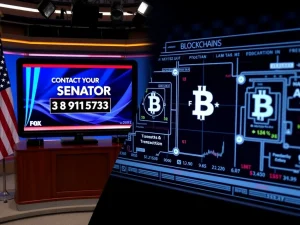Bitcoin ETFs Unleash Stunning $226.6M Inflow, Signaling Renewed Confidence

After a brief period of uncertainty, U.S. spot Bitcoin ETFs have roared back into positive territory, signaling a remarkable shift in institutional sentiment. This resurgence, marked by a substantial $226.6 million net inflow, comes as a welcome relief following a three-day streak of outflows. But what does this mean for the world’s leading cryptocurrency, especially as its price experiences a slight dip? Let’s dive into the fascinating dynamics at play.
A Resounding Reversal: What Triggered the Bitcoin ETF Inflow Surge?
The latest data from July 25, 2025, reveals a significant turnaround for U.S. spot Bitcoin ETFs. After experiencing a cumulative outflow of $285.3 million over three days, these structured crypto products saw a net inflow of $226.6 million. This positive movement is particularly noteworthy as it marks the first time since July 22 that these ETFs have recorded a net positive flow.
- Fidelity’s FBTC led the charge, attracting an impressive $106.6 million.
- VanEck’s HODL followed with a strong performance, pulling in $46.4 million.
- BlackRock’s IBIT, a major player, contributed $32.5 million to the total inflow.
This collective demand underscores a renewed interest in regulated Bitcoin exposure, suggesting that institutional investors are recalibrating their positions and perhaps viewing recent price corrections as buying opportunities.
Decoding the Divergence: Why Did Bitcoin Price Dip Amidst Inflows?
One of the most intriguing aspects of this development is the apparent disconnect between the surge in ETF inflows and Bitcoin’s spot price action. On the same day these significant inflows occurred, Bitcoin’s price actually fell by 1.7% to $115,988. This divergence highlights the complex interplay of factors influencing the Bitcoin price.
Analysts suggest several reasons for this phenomenon:
- Hedging Strategies: Large institutional players often employ sophisticated hedging strategies. They might be buying Bitcoin through ETFs while simultaneously shorting Bitcoin in the futures market or taking other positions to mitigate risk, especially during periods of volatility.
- Long-Term Portfolio Allocations: Many institutional investors are allocating to Bitcoin for long-term portfolio diversification rather than short-term speculative trading. Their purchases through ETFs might not immediately translate to upward price pressure if they are building positions over time or if other market forces are at play.
- Broader Market Sentiment: Despite institutional buying, broader market caution driven by macroeconomic uncertainties or regulatory scrutiny could still exert downward pressure on the spot price. The ETF inflows represent only one segment of the market.
This scenario emphasizes that while ETF demand is a powerful force, it doesn’t always directly correlate with immediate spot price action, especially in a dynamic and evolving market.
Beyond Bitcoin: Ethereum’s Consistent ETF Inflows and Broader Crypto Market Trends
While Bitcoin’s ETF inflows captured headlines, it’s worth noting the robust performance of Ethereum’s spot ETFs. Ethereum (ETH) saw a 0.8% rise to $3,644, with its spot ETFs logging a remarkable $231.2 million in net inflows. This extends their positive streak to an impressive 15 consecutive days, showcasing sustained confidence in the second-largest cryptocurrency.
This broader positive trend in Ethereum ETFs, coupled with Bitcoin’s recent inflow, paints a nuanced picture of the overall crypto market. The consistent demand for both Bitcoin and Ethereum through regulated products suggests that investors are increasingly viewing ETFs as a secure and accessible gateway to digital assets, particularly amidst heightened volatility and evolving regulatory landscapes.
The Power of Institutional Investment: Recalibrating Risk and Opportunity
The recent $226.6 million inflow, while below the average weekly inflow of $300 million seen in early June, still signifies a potential shift in sentiment. It suggests that market participants are recalibrating their risk exposures and finding renewed value in digital assets via regulated avenues. The increasing presence of institutional investment is a critical factor shaping the crypto landscape.
Historically, sustained ETF inflows have provided strong support for Bitcoin during periods of macroeconomic stability. However, current conditions are more volatile, influenced by geopolitical risks and ongoing debt ceiling debates. This makes the resilience shown by ETF investors even more significant, indicating a growing conviction in Bitcoin’s long-term value proposition despite short-term headwinds.
What’s Next? The ETF Landscape as a Barometer for Crypto Appetite
The relationship between Bitcoin’s price trajectory and ETF inflows is likely to remain closely linked in the near term. The July 25 inflow could signal improved confidence, though its long-term impact will depend on broader macroeconomic developments and the continued maturation of the regulatory environment.
For now, the ETF landscape is consolidating its position as a key barometer for institutional crypto appetite. The clear regulatory framework in the U.S. continues to drive demand for structured exposure to digital assets, providing a more predictable and accessible entry point for traditional finance players. As the market evolves, these inflows will remain a crucial indicator of mainstream adoption and confidence in the future of cryptocurrency.
The latest U.S. spot Bitcoin ETF inflows mark a pivotal moment, ending a period of outflows and signaling renewed institutional confidence despite a concurrent dip in Bitcoin’s price. This divergence highlights the sophisticated strategies employed by institutional investors, who are increasingly utilizing regulated products like ETFs for long-term allocation and hedging. Coupled with Ethereum’s consistent inflows, the broader crypto market shows a robust appetite for structured digital asset exposure, positioning ETFs as a crucial indicator of future market trends and institutional adoption.
Frequently Asked Questions (FAQs)
Q1: What are U.S. Spot Bitcoin ETFs?
U.S. Spot Bitcoin ETFs (Exchange-Traded Funds) are investment vehicles that hold actual Bitcoin, allowing investors to gain exposure to Bitcoin’s price movements without directly owning the cryptocurrency. They trade on traditional stock exchanges, offering a regulated and accessible way for both retail and institutional investors to participate in the Bitcoin market.
Q2: Why did Bitcoin’s price fall despite ETF inflows?
The divergence between Bitcoin ETF inflows and a falling spot price can be attributed to several factors. Institutional investors might be employing hedging strategies, taking long-term positions that don’t immediately impact short-term spot prices, or the broader market sentiment driven by macroeconomic factors might be exerting downward pressure independently of ETF demand.
Q3: Which Bitcoin ETFs saw the largest inflows?
According to SoSoValue data, Fidelity’s FBTC led the inflows with $106.6 million, followed by VanEck’s HODL at $46.4 million, and BlackRock’s IBIT at $32.5 million on July 25, 2025.
Q4: How do Bitcoin ETF inflows impact the overall crypto market?
Bitcoin ETF inflows are a strong indicator of institutional confidence and demand for cryptocurrencies. While they don’t always directly correlate with immediate price movements, sustained inflows signal growing mainstream adoption and provide a foundation for long-term price stability and growth. They also reflect the success of regulated products in attracting traditional finance capital into the crypto market.
Q5: Are Ethereum ETFs also seeing significant inflows?
Yes, Ethereum spot ETFs have shown remarkable performance, logging $231.2 million in net inflows on July 25, 2025, extending their positive streak to 15 consecutive days. This indicates strong and consistent institutional interest in Ethereum as well.








